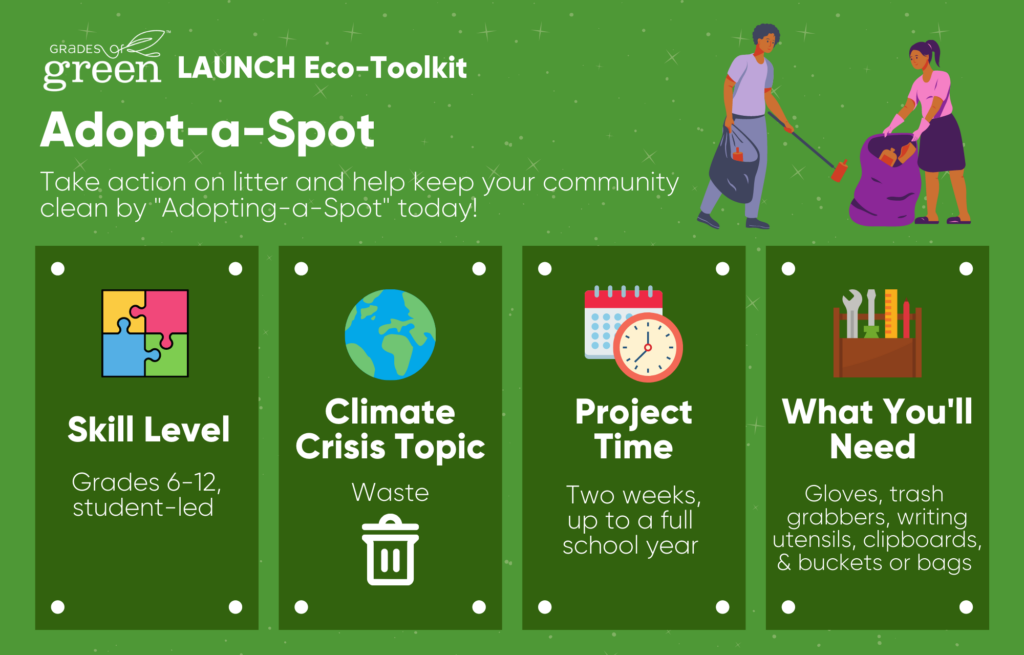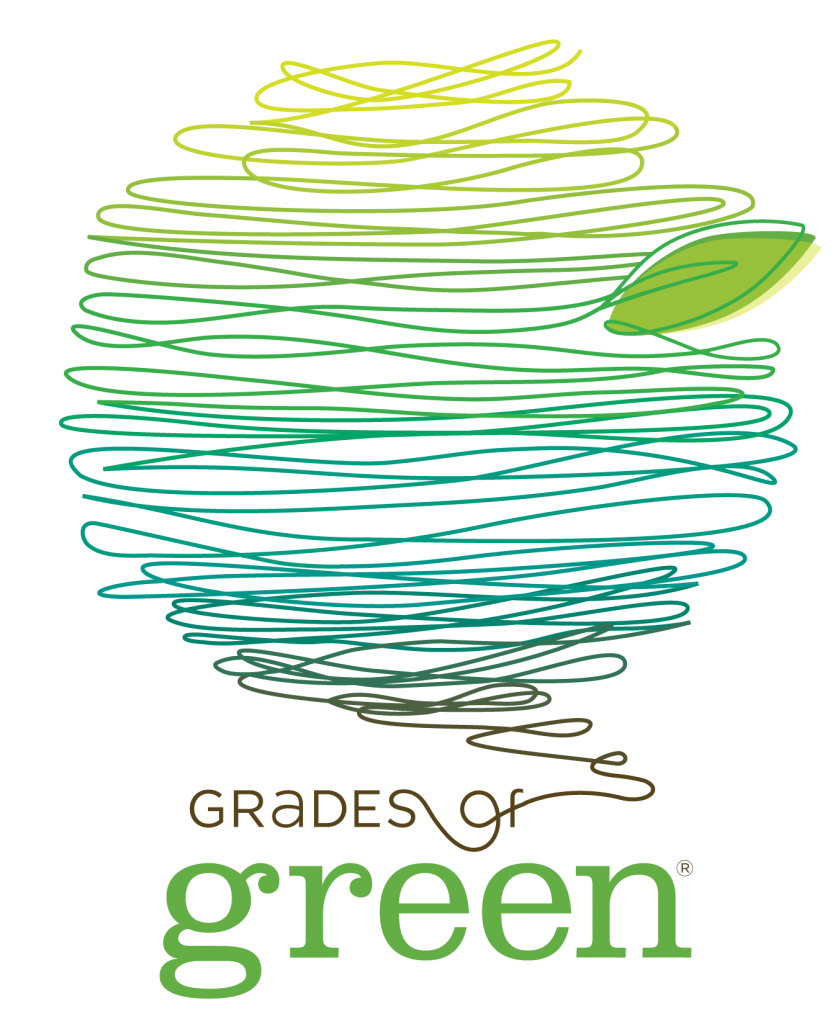Adopt a Spot and clean your community!
When you “Adopt a Spot” the same way you would a new puppy or pet, you have an amazing opportunity to be responsible for keeping your chosen area clean and healthy!

Toolkit Details


NGSS
This toolkit address the following Science and Engineering Practices (SEPs) within the Performance Expectations of NGSS for Grades: 6-8 and 9-12
- Asking Questions and Defining a Problem
- Planning and Carrying out Investigations
- Analyzing and Interpreting Data
- Using Mathematics and Computational Thinking
- Constructing Explanations and Designing Solutions
- Obtaining Evaluating, and Communicating Information
Learning Objectives
- Analysis
- Students will analyze their campus for litter “hot spots”
- Project Management
- Students will identify routines to accomplish their goals
- Students will practice leadership skills by delegating tasks to each other
- Evaluation and Assessment
- Students will track and evaluate the impact of their project
Why It’s Important
Imagine waking up everyday to trash on the streets and limited efforts from the city and garbage collection companies to pick up that trash.Litter damages the environment, harms animals and people, wastes money, and makes communities with poorer, Indigenious, or People of Color feel neglected and under-valued. This makes trash an Environmental Justice issue. It also affects how these residents feel about their lives and neighborhood.
What You Will Accomplish
Participants take action to ensure specific campus areas stay litter-free.
Why Litter is Rubbish
The resources provided can be shown as a slideshow or printed out as individual worksheets for students to learn.

People Make A LOT of Litter!
You might only see a few pieces of litter on your street, but researchers found that on average there are more than 13 thousand pieces of litter per mile on American roadways. All together, it’s estimated there are 51 billion pieces of litter on all US roads at any moment. [1] If you add in ocean litter, there are more pieces of plastic in the seas than there are stars in the galaxy.
Litter Travels!
A plastic wrapper dropped in the parking lot doesn’t stay there for long. It gets blown to the curb, washed through storm drains, into rivers, and out to sea. Scientists estimate that almost 9 million tons of plastic litter end up in the ocean—every year. This is the equivalent of five grocery bags filled with plastic trash sitting on every foot of coastline around the world. [2]
Litter Hurts!
Litter affects animal and human health. It’s estimated that over 1 million land animals and 100 million sea animals die each year after eating or becoming trapped in litter. Litter also releases chemicals and tiny pieces of plastic debris leftover from the products we use called microparticles as it breaks down in the environment. These toxic particles end up in the air, in our water, and in the soil where we grow food. [3]
Litter is Contagious!
When people see litter or others littering, they are more likely to litter themselves. In fact, research shows that about 15% of littering activities are motivated by existing litter in an environment. When you “Adopt a Spot” in your community, you help keep it clean, make less garbage, and teach others not to leave trash on the streets. [4]
Why Litter is a Environmental Justice Issue
Communities with higher average incomes tend to have more waste hauling and sanitation services than those with lower average incomes making litter an environmental justice issue. People in underserved communities are more likely to live amongst trash, and the litter that accumulates in these areas can have serious health effects. Communities that are underserved are more likely to be affected by microplastics, harmful pieces of plastic that harm oceans and wildlife, because the food they eat is more likely to be contaminated by microplastics, creating a health hazard. In addition to the physical problems, studies have also shown that litter can have a negative psychological impact on humans due to the emotional connection people have with nature. It is important to make sure that all communities have the resources to remove litter.
Watch these two short videos to learn why it’s important to keep your campus clean!
Think About It!
Pre-Activity Questions
- Describe places in your school or community where you see a lot of litter.
- What kinds of litter do you see? What are the most common types?
- Why do you think these items become litter so often?
- Why do you think you may sometimes look past litter when you see it?
Take Action: How to LAUNCH Adopt-A-Spot
Follow the steps below to set up a successful Adpot-A-Spot Campaign at your school! Need help? Contact us!
Step 1: Assign Roles
- Determine who and how many students/staff are participating
- Invite attendees to support your clean up efforts. Use the Adopt-A-Spot Invite and Safety Guidelines Template
- Use the Adopt-A-Spot Sign Up Sheet to track additional participants
Step 2: Map It Out
Look at a map of your school or neighborhood. Make a list of areas that are full of litter and can be “up for adoption”.
It’s amazing how much more we care about something once we’ve given it a name. Just like you would name a pet, naming “your” spot can build a real feeling of ownership and pride. (Plus, it’s fun!)
Step 3: Prepare Your Materials
Gather your litter collection supplies and choose an accessible location where they can be stored.
Materials:
- Garden Gloves
- Trash Grabbers
- Buckets
- Bags for trash and recycling
- Clipboards with printed litter trackers for each team
- Writing utensils
Step 4: Make a Schedule
Decide a time to begin cleaning the litter in your spots. Set up a schedule to check on your spot and keep it clean daily, weekly, or monthly depending on what your spot needs.
- Determine the start and end dates of your campaign. If it is ongoing, plan to check in from time to time to monitor your progress.
- Use our Adopt-A-Spot Team Organizer to help keep your team organized.
- Remember to keep your team safe!
Take pictures of your team working in “your” spot. Everyone loves to see themselves and their friends in action. It’s a great way to build a sense of belonging and community. Create a unique hashtag or social media page for your photos.
You never know what strange or unexpected items a litter pick-up may uncover. Keep a “treasures” list and read the list periodically. Being a litter-buster has a fun side!
Step 5: Track Your Impact
Each group that has a spot should track their progress with our Adopt-A-Spot Litter Tracker. Collect sheets weekly to keep track of your impact.
Keep track of the more commonly discarded items, o if there are increases in litter during different times of the year – like fun-size candy wrappers after Halloween. Are there things you can do to reduce these items? Recycle or compost as much of the waste as you can. (Contact your city or waste hauler to find out more)
Create a leader board or use the Litterati app to track your litter pick up to see who picks up the most. Offer a prize for the winning person, team, or classroom!
Reflection Questions
How’d It Go?
- What were some things that went well during your project?
- What could you do to make your pickups even better next time??
- Which items of litter did you find the most of?
Report Students’ Impact
Congratulations!! You’ve implemented Adopt a Spot! Don’t let all that hard work go unnoticed. Submit your results by clicking the green button below.
Project ongoing? No problem! Let us know what you’ve done so far.
By reporting your impact, Grades of Green can:
- CELEBRATE and elevate your students’ hard work and success.
- Offer our programs FREE for all students across the globe.
- AWARD stipends and certificates to hard-working educators and students.
Please take a few minutes to submit your results. Thank you!
Provided Resources
- Adopt-A-Spot Team Organizer
- Adopt-A-Spot Invite and Safety Guidelines Template
- Adopt-A-Spot Sign Up Sheet
- Adopt-A-Spot Litter Tracker
- Adopt-A-Spot Slides
- Adopt-A-Spot Wrap Up Form
- Use the Litterati App to track your litter cleanup efforts: https://www.litterati.org
- Toolkit Resources – Google Drive Folder
Congrats on completing the Adopt-a-Spot Eco-Toolkit!
Did you enjoy this toolkit? Find your next project here!
